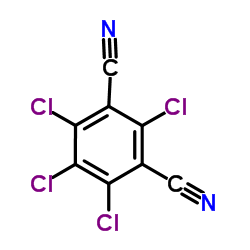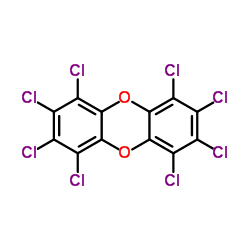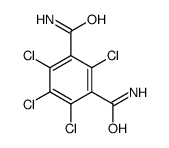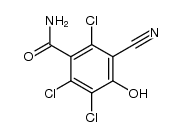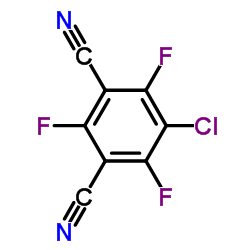1897-45-6
| Name | chlorothalonil |
|---|---|
| Synonyms |
meta-TCPN
2,4,5,6-Tetrachloroisophthalonitrile Chloroalonil MFCD00045594 2,4-Dicyanotetrachlorobenzene 1,3-dicyano-2,4,5,6-tetrachlorobenzene 2,4,5,6-tetrachlorobenzene-1,3-dicarbonitrile 2,4,5,6-tetrachloro-1,3-benzenedicarbonitrile m-Tcpn 2,4,5,6-tetrachloro-1,3-dicyanobenzene Nopcocide TPN Perchloroisophthalonitrile 2,4,5,6-tetrachloroisophthalodinitrile Chlorothalonil EINECS 217-588-1 tetrachloroisophthalonitrile Bravo Daconil 1,3-Benzenedicarbonitrile, 2,4,5,6-tetrachloro- Tetrachloroisophthalodinitrile 1,3-dicyanotetrachlorobenzene |
| Description | Chlorothalonil is a broad spectrum fungicide and is effective in protecting plants against fungal diseases caused mainly by Phytophthora infestans and Alternaria solani. Chlorothalonil is used for controlling of fungal foliar diseases of vegetables and crops[1][2]. |
|---|---|
| Related Catalog | |
| References |
| Density | 1.7±0.1 g/cm3 |
|---|---|
| Boiling Point | 350.5±37.0 °C at 760 mmHg |
| Melting Point | 250-251ºC |
| Molecular Formula | C8Cl4N2 |
| Molecular Weight | 265.911 |
| Flash Point | 153.8±20.7 °C |
| Exact Mass | 263.881561 |
| PSA | 47.58000 |
| LogP | 2.88 |
| Vapour Pressure | 0.0±0.8 mmHg at 25°C |
| Index of Refraction | 1.633 |
CHEMICAL IDENTIFICATION
HEALTH HAZARD DATAACUTE TOXICITY DATA
MUTATION DATA
|
| Symbol |




GHS05, GHS06, GHS08, GHS09 |
|---|---|
| Signal Word | Danger |
| Hazard Statements | H317-H318-H330-H335-H351-H410 |
| Precautionary Statements | P260-P273-P280-P284-P304 + P340 + P310 |
| Personal Protective Equipment | Eyeshields;Faceshields;full-face respirator (US);Gloves;multi-purpose combination respirator cartridge (US);type ABEK (EN14387) respirator filter |
| Hazard Codes | T+;N |
| Risk Phrases | R26;R37;R40;R41;R43;R50/53 |
| Safety Phrases | S28-S36/37/39-S45-S60-S61-S36/37-S26 |
| RIDADR | 3276 |
| RTECS | NT2600000 |
| Packaging Group | I |
| Hazard Class | 6.1(a) |
| HS Code | 2926909090 |
| Precursor 0 | |
|---|---|
| DownStream 8 | |
| HS Code | 2926909038 |
|---|---|
| Summary | HS: 2926909038 fenoxanil Educational tariff:17.0% Tax rebate rate:9.0% Regulatory conditions:S(Registration certificate of import and export) Lowest tariff:6.5% General tariff:30.0% |

